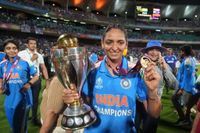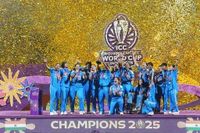The cricketing world witnessed a seismic shift on November 3, 2025, as India’s women’s cricket team clinched their maiden ICC Women’s Cricket World Cup title, defeating South Africa by 52 runs in front of a roaring crowd at Navi Mumbai’s DY Patil Stadium. For a nation long steeped in cricketing tradition, this victory was more than just a win—it was a watershed moment that many believe will reshape not only women’s cricket, but the landscape of women’s sports across India.
The journey to this historic triumph was anything but straightforward. Since making their World Cup debut as hosts in 1978, India’s women had come agonizingly close on several occasions, reaching the semifinals in 1997 and finishing runners-up in 2005 and 2017. The heartbreak of those near-misses, particularly the narrow nine-run defeat to England in 2017, lingered for years. Captain Harmanpreet Kaur, who was part of that 2017 squad and famously scored an unbeaten 171 against Australia in the semifinals, reflected on the team’s resilience: “Every time we lost, we went home heartbroken and stayed quiet for a few days. When we returned, we said we have to start again from ball one. It was heartbreaking because we played so many World Cups, reaching finals, semifinals and sometimes not even that far. We were always thinking, when will we break this?”
Break it they finally did. In front of 45,000 fans, the Indian team delivered a performance for the ages. The youngest member, Shafali Verma, just 21 years old, dazzled with 87 runs and two wickets—a remarkable feat for someone who, a dozen years ago, disguised herself as a boy in Haryana just to play the sport she loved. The crowd’s energy was palpable, with celebrations spilling well past midnight. Mumbai fan Tanvi Agrawal summed up the mood: “It was a late night, but it feels like everyone woke up on Monday with a smile on their face. When I was a girl at school, there were no opportunities to play cricket. It made me feel so proud and emotional to see this win. We have come a long way and there is no limit now for these players.”
The victory was not just about the players on the field. India’s cricketing legends and public figures joined the chorus of congratulations. Sachin Tendulkar, who famously inspired a nation with his exploits, drew a parallel with the men’s team’s iconic 1983 World Cup win: “1983 inspired an entire generation to dream big and chase those dreams. Today, our women’s cricket team has done something truly special. They have inspired countless young girls across the country to pick up a bat and ball, take the field and believe that they too can lift that trophy one day.” Prime Minister Narendra Modi and others echoed this sentiment, acknowledging the broader impact of the triumph.
This World Cup win didn’t come out of the blue. After a disappointing group-stage exit in the 2022 edition, the Board of Control for Cricket in India (BCCI) and other stakeholders intensified efforts to professionalize and promote the women’s game. The BCCI’s 2022 decision to mandate equal pay for men and women in international matches was a game changer, leading to greater professionalism and improved fitness levels. The launch of the Women’s Premier League in 2023, backed by a $500 million investment, further expanded the talent pool and gave young players a platform to shine. By 2025, stars like Kranti Goud and Shree Charani—both of whom made their international debuts earlier in the year—played pivotal roles, with Goud taking nine wickets in eight matches and Charani claiming 14 wickets in nine games.
The 2025 tournament itself was a spectacle. Eight teams battled over five weeks, with India’s path to the final marked by grit and determination. The semifinal victory over Australia, the seven-time world champions, was a psychological breakthrough, as former player and coach Aarti Sankaran noted: “It’s not because they beat Australia, it is because how things have changed. From where we started to where we are today, there is no comparison.” Jemimah Rodrigues, whose heroics in that match brought her to tears, embodied the emotional rollercoaster experienced by the team and its supporters.
Off the field, the celebrations reflected the magnitude of the achievement. After collecting their winners’ medals and posing for photographs long after midnight, the team passed the trophy to former greats like Jhulan Goswami, who played in five World Cups and was part of the 2017 heartbreak. Goswami expressed confidence that this win would set a new benchmark: “This self-belief and the mindset to develop individually as players will forge them stronger as a team. This will set a benchmark for future Indian teams to come back even in tough situations because they will know how to do it.”
Yet, as of November 4, the BCCI had not finalized plans for a grand victory parade. BCCI secretary Devajit Saikia explained, “Nothing like a victory parade is planned as of now. I’m leaving for Dubai to attend the ICC meetings. Several senior officials are heading there as well, so once we return, we will plan accordingly.” Nevertheless, the board announced a cash prize of Rs 51 crore for the players, coaches, and support staff—a fitting recognition for a team that has, as Saikia put it, “won the hearts of all Indians.”
The financial rewards for women’s cricket have been on the rise. The 2025 World Cup’s prize pool jumped to nearly $14 million, up from $3.5 million in the previous edition. Top players in the Women’s Premier League now earn nearly half a million dollars for a season, and, according to Indian Sport Management Association president Sarthak Mondal, “In terms of revenue generated from the Premier Leagues, women get paid 2% more than men.” While disparities remain—male players still command larger annual retainers and commercial deals—the gap is narrowing, signaling a shift toward greater equity.
The significance of this victory goes beyond cricket. As vice captain Smriti Mandhana noted, “The ultimate dream is to see a street cricket match with two girls’ teams playing... A World Cup win will be a step toward that for sure.” The hope is that this triumph will inspire more girls to take up sports, drive increased investment at the grassroots level, and challenge deeply entrenched social norms. Shaji Prabhakaran, former general secretary of the All India Football Federation, believes the ripple effects could extend to other sports as well: “There is no doubt that other sports will be inspired and motivated by what the women’s cricketers have done.”
For Harmanpreet Kaur, who once juggled a railway clerk’s job with her cricketing ambitions, the victory lap in Mumbai was a world away from her early days of rushing to catch the last train home after practice. As she stood on stage, fireworks lighting up the night sky and a nation celebrating, Kaur summed up the moment: “The celebration will go on all night.” With the promise of more to come, India’s women’s cricket has well and truly arrived on the world stage.






